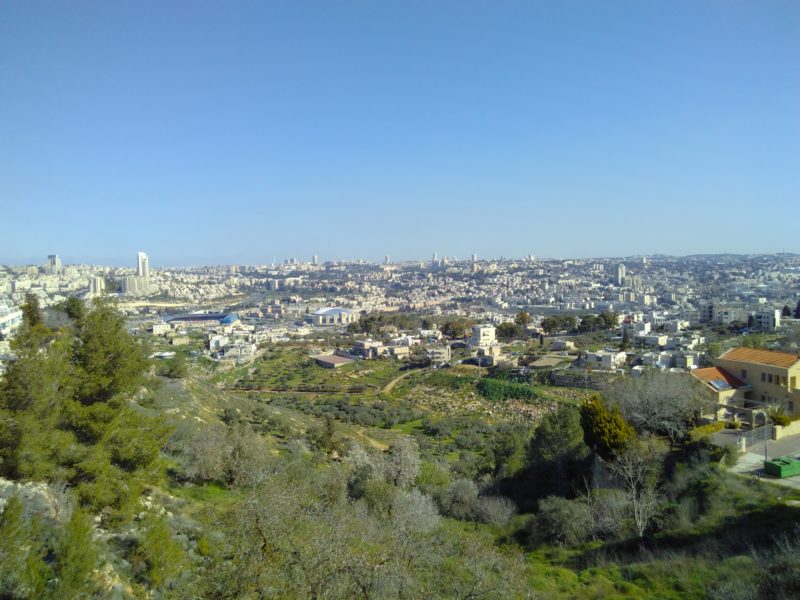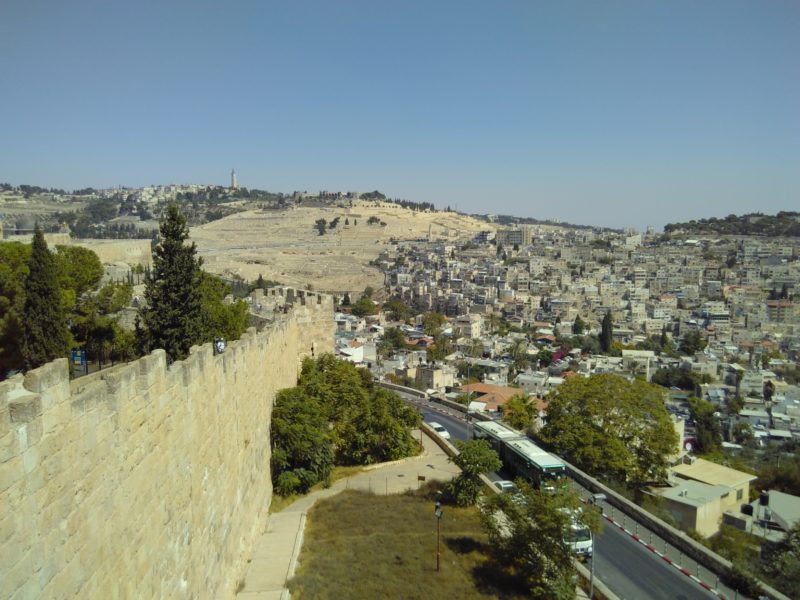The ‘Rain City’. That is how Seattle is known informally. Whenever I meet someone new from either ‘my’ sangha (Sanskrit for ‘community’) at NalandaWest or the neighbourhoods of Fremont & Wallingford, it is one of the first things they ask: “are you used to the rain already?” Or they simply, apologetically or as a matter of fact, say: “it rains a lot here.” Many people, not just Seattleites, often wish for a bright blue sky. In the same way we are looking for a life without disturbances – with a mind that is calm, happy and at ease. However, it seems equally hard to avoid rainy days – certainly in the Rain City – as it is to avoid disturbances in life. So, how to get there?

Mind is like the sky and it’s clouds
The comparison of our life & mind with the sky and its clouds is often found in mindfulness-trainings. It is an easy and effective one. The bright blue sky is linked to the mind. While appearing clouds are like our thoughts, emotions and experiences with our senses – passing through our mind. What if we can learn not to be disturbed by these appearances? To sit and watch the clouds drifting? To accept them coming and going – whether small and light or big and dark? The quality of our life increases very strongly. Right? Isn’t this all we are looking for?
Mindfulness: positive effects & questions
Many mindfulness-based trainings, therapies and so on indeed promise: it reduces stress, helps you deal with depression, anxiety and all other kinds of suffering you might face in life. Though mindfulness-practices in this, let’s say’, ’therapeutic’ way are relatively young, science has indeed supported the effectiveness of it. Many experiments are showing results that are very promising.1More about the science behind the practice of mindfulness can for example be found here: https://www.scientificamerican.com/article/mindfulness-the-science-behind-the-practice/. If you want to go more in-dept: much more can be found just using the terms ‘science’ and ‘mindfulness’ with any search engine Therefore, there is good reason for all of us to develop more mindfulness in life.
Be this as it may, I keep coming across people that feel a bit uncomfortable with the popularity of mindfulness. Some suggest there is something wrong with the term itself. Others are concerned that mindfulness becomes equal to any kind of meditation, while the latter has much more to offer. Moreover, many people familiar with and / or engaging in buddhist tradition point to the way mindfulness is marketed in the ‘western world’ as a simple technique, while in buddhism it is about a spiritual journey – which is in their view what we need to go on in order to find the very meaning of life.
It is without doubt that mindfulness in the ’therapeutic’ sense has a lot of positive effects. Not only because scientific studies show this. It is something we can all experience. At least, I have found myself what a great support it offered me. Whether it was in personal relationships, dealing with the extreme busyness of my life, or the students in my philosophy classes at secondary school whom challenged me in many ways. It even led me to join a teacher-training, both for adults and a special program designed for adolescents (called ‘.b’).2For more information about ‘.b-curriculum’, check here: https://mindfulnessinschools.org

At the same time, I also became familiar over the years with buddhist philosophy & meditation-practices. In particular Tibetan-buddhism and the so-called Dzogchen-tradition. From this perspective, I can understand some skepticism, doubts, questions and so forth. It goes beyond the scope of my knowledge and writing of this article to discuss these into great length. A good friend is doing her PhD on this topic – which illustrates both the relevance and complexity of the topic. But for everyone familiar with either mindfulness or buddhism, or both, I intend to raise some questions to explore the role of mindfulness in our daily live, practices and what we are really looking for.
The term ‘mindfulness’ and it’s practice
There are at least two ways to contemplate about mindfulness: looking at the meanings of the term and how it is practiced. Let us start with the first one. Mindfulness as it became popular in the ’therapeutic’ contexts is defined as follows: “Awareness that arises through paying attention, on purpose, in the present moment, non-judgementally.”3Source: https://www.mindful.org/jon-kabat-zinn-defining-mindfulness/ This refers to being able to observe the clouds without becoming attached and identify yourself as being your thoughts, emotions or sense-experiences. Which allows for space, calmness and more focus as well.
The term ‘mindfulness’ is derived from the Sanskrit Smṛti. Though this includes the meaning of being present and focused, it also points to ‘memory’ or ‘recollection’. Following this, we can ask: what is there to remember or recollect? This question is debated in buddhist traditions for centuries – from the very beginning. Though ultimately it is something we need to discover this for ourselves, it is possible to point to some related aspects in buddhist traditions and corresponding terms to help us: introspection (saṃprajanya), wisdom (prajñā), the nature of mind (buddhadhātu) and the noble eightfold path that brings and end to the causes of suffering (āryāṣṭāṅgamārga).
So, what about mindfulness in practice? As I said earlier, I have found in both research and from my own experience how mindfulness as a training in the ’therapeutic’ sense is very helpful. It supported me strongly in dealing with the many clouds that appeared. I can relate to them differently, and they become smaller and lighter. Yet, they keep coming. And there seems to be more to life than being able to observe them – increasing my calmness and focus. Mindfulness as such does not seem to teach me values, develop a noble heart or point to the very meaning of life. For example, it can enable someone to manipulate people more easily for his or her own benefit. It even allows the USA and other countries to use mindfulness and make warriors more effective in battle.
It is not without reason that in the buddhist tradition texts speak about ‘right mindfulness’.4See for more information about right mindfulness this article: https://www.learnreligions.com/right-mindfulness-450070 They point to a connection with ethics (Sanskrit: sīla) and emphasize it is one of the teachings to become free of suffering among seven others (hence ’the eightfold path’). Thus, it seems, we are not only looking for something more than mindfulness. We actually need more. Both to have a good and meaningful life ourselves and to develop qualities that lead to virtuous actions – to change the world for the better.5See for more about buddhist teachings on mindfulness for example this article: https://www.lionsroar.com/buddhist-teachings-on-mindfulness-meditation/
Religion or a spiritual journey?
The comparison of the mind with the bright blue sky and clouds appearing is wonderful and older than buddhism. Mindfulness, both in term and practice, is thus not necessarily ‘buddhist’. This also has allowed mindfulness-based practices to be introduced as ‘secular’ and make it widely popular in the western parts of this world today.
In fact, the meeting of the eastern philosophical or religious traditions with ’the west’ has even led to debates in the former about their own way of doing things. It sees, for example, how buddhism can sometimes become like a religion. Whereas the very heart of buddhism, since the buddha himself, is about our own spiritual journey.
In his wonderful book Homo Deus, Yuval Noah Harari has clearly pointed to the difference between these. “Religion,” he writes, “gives a complete description of the world, and offers us a well-defined contract with predetermined goals.” While spiritual journeys “take people in mysterious ways towards unknown destinations.” A journey that usually starts with a big question like ‘who am I?’ or ‘what is the meaning of life?’ In addition, Harari says, “most people just accept the ready-made answers provided by the powers that be, spiritual seekers are not easily satisfied. They are determined to follow the big question wherever it leads, and not just to places they know well or wish to visit.”6Check his book Homo Deus, his website ynharari.com or simply see the use of the distinction with these quotes here: https://medium.com/@ARTaghavi/a-simple-way-to-differentiate-between-religion-and-spirituality-e026b70e8a01 Similar to Harari the XIVth Dalai Lama stresses to take buddhism not as a religion, but as a spiritual guidance on our own path.7See for example this interview: https://www.youtube.com/watch?v=yWoGSIzVokc
Mindfulness in the western world, rooted in buddhist tradition, has tried to get rid of the ‘religious aspects’. Though this certainly increased the accessibility to many people, it appears that is has lost a certain depth and meaning along the way. It can set people on a spiritual journey, lead to introspection and contemplating whether they relate to the world in a good manner. But as the example of mindfulness in the military shows: it can just as well become a technique used for non-virtuous actions, violence and cause suffering. Even when applied just to our own individual life, it can do more damage than good if not done skillfully and without proper guidance. It can make psychological struggles worse, or even be a cause for them.8Read for example the following article by Barbara O’Brien: https://www.learnreligions.com/the-mindfulness-controversy-449769
So, the question maybe for both buddhist traditions as mindfulness in the ’therapeutic’ context is: how can it encourage, stimulate and guide people in their own individual spiritual journey? A training of the mind to become more aware, calm and open. As the bright blue sky. But also embedded in teachings about ethics, meaning and compassion. Something that can be found within ourselves according to buddhism and is often represented by the sun in the comparison often used for the mind.
Being free in the rain
The bright blue sky and the sun are always there, no matter how rainy it is. Which I recently saw beautifully in Seattle as well. But I was also reminded of the perspective of the Dzogchen tradition, which became part of my spiritual journey.
Rather than considering the clouds as covering or disturbing our mind, they are in reality equally free and joyful. Or, put differently, they are an expression of the nature of mind that is free and joyful by itself. There is nothing we need to do. We only need to remember, or recollect – the other translation of the Sanskrit term Smṛti. Clouds, whatever size or lightness/darkness, rain, or also snow and other phenomena happening in the sky: they all part of the same expanse. Which, according to Dzogchen, is compassionate by it’s very nature. How this works? Whether this is even true? I guess that is part of the spiritual journey. Similar to what Harari & the XIVth Dalai Lama pointed out, Dzogchen Ponlop Rinpoche says it is much more important to ask questions than find answers.

I wish this article contributes every reader in his or her own spiritual journey, wherever you are on this planet. Though I guess there is a point Seattle is informally known as the ‘Rain City’ and officially ’the Queen city’ and ’the Emerald City’ as well. Enlightenment, Nirvana, Dzogchen Ponlop Rinpoche likes to joke, can be found only in Seattle. But knowing that the sky and both it’s sun, clouds & rain is all around us, we can actually find it anywhere our spiritual journey takes us. The difference is not made by where we are, but which practices we take upon ourselves and why. Mindfulness can be a great support on our journey, even necessary, but whether it is sufficient? I personally have the impression we are looking for more and need more.
The dear friend of mine who is researching this – much more in-depth than I am able to offer here – suggested that perhaps mindfulness in the ‘secular’ / ’therapeutic’ sense is taking us to a gate. Beyond that gate lies both a wisdom about our reality and training to become more kind & compassionate, where mindfulness as such might not take us. In other words, it does in fact bring us closer to the world of ethics, virtuous actions and meaning in life. Therefore, it is very beneficial to introduce people to mindfulness in this manner. I am not sure whether it works like this. Moreover, what is it that would make one walk through the gate? This certainly is an interesting way of looking at it.
I am curious to know: what are your ideas about mindfulness, it’s roots in and relationship with buddhism and how both relate to what we are truly looking for? What do you find in your experience? Let us start a dialogue. And, who knows, we might meet in the Rain City at NalandaWest – experiencing freedom, joy and compassion in whatever way the sky appears to us.




